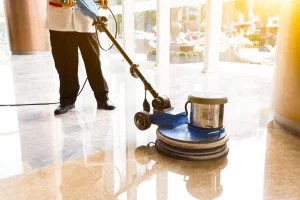

what are Marble Polishing Services?
Marble polishing services refer to professional services provided by trained experts who specialize in restoring the shine and luster of marble surfaces. These services are typically offered by specialized cleaning and restoration companies or professionals who have extensive knowledge and experience in working with marble.
Marble polishing services involve a series of processes and techniques designed to remove scratches, stains, and other imperfections from marble surfaces and restore them to their original beauty. The goal is to achieve a smooth, reflective, and polished finish that enhances the natural characteristics of the marble.
The specific steps involved in marble polishing services may vary depending on the condition of the marble and the desired outcome. Generally, the process includes thorough cleaning of the marble surface to remove dirt and grime, followed by the use of specialized equipment, such as rotary machines or floor buffers, along with polishing pads or abrasive compounds to gently buff and polish the surface.
Why Marble Polishing is Essential for Maintaining the Beauty of Your Floors
Professional marble polishing services may also include additional treatments, such as diamond grinding to remove deeper scratches or etching, honing to even out the surface, and sealing to protect the marble from future damage and stains.
Marble is a stunning natural stone that adds elegance and sophistication to any space. However, over time, marble floors can lose their shine and develop signs of wear and tear. This is where marble polishing becomes essential for maintaining the beauty of your floors. Here are some key reasons why marble polishing is crucial:
Restoring the Natural Shine: Foot traffic, spills, and regular cleaning can cause marble floors to become dull and lose their natural shine. Polishing helps to remove the outer layer of the marble, revealing a fresh surface and restoring its original luster. This process brings back the radiant beauty of your marble floors, making them look as good as new.
Eliminating Scratches and Etching: Marble is susceptible to scratches and etching caused by sharp objects, abrasive materials, and acidic substances. These imperfections can detract from the overall appearance of your floors. Through the polishing process, scratches and etching are minimized or completely removed, leaving behind a smooth and flawless surface.
Enhancing Color and Patterns: Polishing not only restores the shine but also enhances the natural color and veining patterns of your marble floors. It brings out the inherent beauty and character of the stone, making it more visually appealing.
Increasing Resistance to Stains: Polished marble has a smoother surface, which makes it more resistant to stains and spills. The polishing process closes the pores of the marble, reducing its absorbency. This protective barrier helps prevent liquids and substances from penetrating the stone, making it easier to clean and maintain.
Improving Durability and Longevity: Regular marble polishing helps maintain the structural integrity of the stone. By removing surface imperfections and reinforcing the strength of the marble, polishing can extend its lifespan. It protects against further damage and ensures that your floors continue to withstand everyday use for years to come.
Facilitating Easy Maintenance: Polished marble floors are easier to clean and maintain. The smooth surface prevents dirt, dust, and grime from accumulating in the pores, making routine cleaning more efficient and effective. Regular sweeping, mopping, and occasional polishing can keep your marble floors looking pristine with minimal effort.
Preserving Property Value: Marble floors are a significant investment, and their condition plays a crucial role in maintaining the value of your property. Well-maintained, polished marble floors significantly enhance the overall aesthetic appeal of your space, contributing to a positive impression for residents, guests, or potential buyers.


The benefits of hiring marble polishing services include:
Restoring the natural beauty: Marble polishing can bring back the original shine and luster of the marble, enhancing the aesthetics of the space.
Removing imperfections: Polishing can effectively eliminate scratches, stains, and etching, making the surface appear smooth and flawless.
Extending the lifespan: Regular polishing helps maintain the integrity of the marble, preventing further deterioration and prolonging its lifespan.
Professional expertise: Trained professionals have the knowledge, skills, and specialized equipment to handle marble surfaces effectively and ensure optimal results.
Time-saving: Marble polishing can be a time-consuming process, but hiring professionals allows you to save time and effort while achieving superior results.
Marble polishing is a meticulous process that requires attention to detail and the right techniques to achieve optimal results. In this guide, we will provide you with practical content and step-by-step instructions to help you effectively polish your marble surfaces.
Step 1: Assessing the Condition of Your Marble:
Before beginning the polishing process, thoroughly examine your marble surfaces to identify any scratches, stains, or etching. Note the areas that require special attention and make a plan for addressing each issue.
Step 2: Cleaning the Marble Surface:
Start by cleaning the marble surface to remove any dirt, dust, or debris. Use a pH-neutral cleaner specifically designed for marble and follow the instructions provided by the manufacturer. Avoid using acidic or abrasive cleaners as they can damage the marble.
Step 3: Removing Surface Scratches:
For minor scratches, you can try using a marble polishing powder. Mix the powder with water to form a paste and apply it to the scratched area. Use a soft cloth or a low-speed buffer with a polishing pad to gently work the paste into the scratch in a circular motion. Continue until the scratch is no longer visible, then wipe away any residue with a clean, damp cloth.
Step 4: Treating Stubborn Stains:
If your marble surface has stubborn stains, create a poultice to draw out the discoloration. Mix a powdered poultice material, such as baking soda or talc, with a liquid solvent recommended for marble, such as hydrogen peroxide or acetone. Apply the poultice mixture to the stain, ensuring it covers the entire affected area. Cover it with plastic wrap and let it sit for the recommended time specified by the poultice manufacturer. Afterward, remove the poultice and rinse the area with water. Repeat the process if necessary.
Step 5: Polishing the Marble Surface:
To achieve a polished finish, you can use a marble polishing services compound or a polishing powder specifically formulated for marble. Apply a small amount of the polishing product onto the marble surface and use a clean, soft cloth or a low-speed buffer with a polishing pad to work the product into the marble. Move the cloth or buffer in a circular motion, applying gentle pressure. Continue polishing until you achieve the desired level of shine.
Step 6: Sealing the Marble Surface:
Once the polishing is complete and the surface is dry, consider applying a marble sealer to protect the newly polished marble. Choose a high-quality sealer that is compatible with your marble type. Follow the manufacturer’s instructions to apply the sealer evenly, allowing it to penetrate the marble. Wipe away any excess sealer and allow the surface to dry completely.
Conclusion:
By following these practical steps, you can successfully polish your marble surfaces and restore their natural beauty. Remember to exercise caution, use the appropriate products, and take your time to achieve the best results. Regular maintenance and care will help prolong the polished finish and keep your marble looking stunning for years to come




